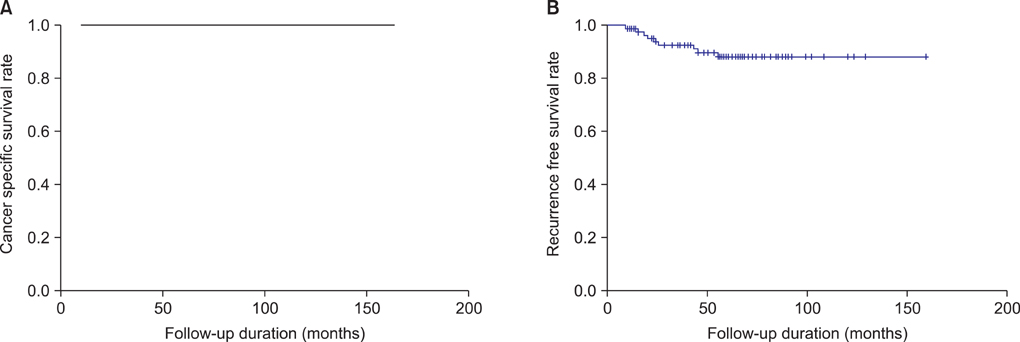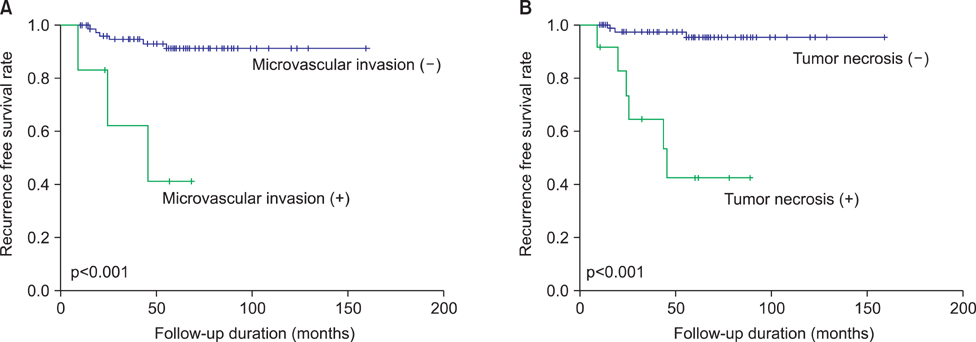Korean J Urol.
2010 Apr;51(4):233-238.
The Prognostic Factors for Patients with pT1a Renal Cell Carcinoma
- Affiliations
-
- 1Department of Urology, College of Medicine, Yeungnam University, Daegu, Korea. htkim@ynu.ac.kr
Abstract
- PURPOSE
Although the prognosis of patients with pT1a stage renal cell carcinoma (RCC) is generally good, some of these patients show distant metastasis. In this study, we intended to identify the perioperative and pathologic prognostic factors for patients with pT1a stage RCC. MATERIALS AND METHODS: A total of 93 patients who were diagnosed with pT1aN0M0 RCC between January 1995 and December 2004 were included. All the patients underwent radical (n=63, 67.7%) or partial (n=30, 32.3%) nephrectomy by a single surgeon. Preoperative data [age, sex, body mass index (BMI), and the presence of symptoms], follow-up duration, surgical methods, and pathological parameters (tumor size, tumor location, histologic type, Fuhrman's nuclear grade and the presence of microvascular invasion, hemorrhage, necrosis, calcification, and a cystic component in the tumor) were retrospectively analyzed to identify which of these were prognostic factors for pT1a RCC. RESULTS: The patients' mean age was 55.0+/-11.4 years and the mean follow-up duration was 63.6+/-31.1 months. The 5-year cancer-specific survival rate and the 5-year recurrence- free survival rate were 100% and 88.1%, respectively. Nine patients (9.7%) showed distant metastasis, but local recurrence was not shown. Fuhrman's nuclear grade (p=0.040, OR=5.147), microvascular invasion (p=0.011, OR=13.500), and tumor necrosis (p<0.001, OR=26.000) had a significant impact on distant metastasis in the univariate analysis. The multivariate analysis subsequently showed that microvascular invasion (p=0.033, OR=17.947) and tumor necrosis (p=0.002, OR=15.922) were independent prognostic factors. CONCLUSIONS: Microvascular invasion and tumor necrosis are the prognostic factors for patients with pT1a RCC.
Keyword
MeSH Terms
Figure
Reference
-
1. Volpe A, Jewett MA. The natural history of small renal masses. Nat Clin Pract Urol. 2005. 2:384–390.2. Pantuck AJ, Zisman A, Belldegrun AS. The changing natural history of renal cell carcinoma. J Urol. 2001. 166:1611–1623.3. Janzen NK, Kim HL, Figlin RA, Belldegrun AS. Surveillance after radical or partial nephrectomy for localized renal cell carcinoma and management of recurrent disease. Urol Clin North Am. 2003. 30:843–852.4. Dall'glio MF, Ribeiro-Filho LA, Antunes AA, Crippa A, Nesrallah L, Gonçalves PD, et al. Microvascular tumor invasion, tumor size and Fuhrman grade: a pathological triad for prognostic evaluation of renal cell carcinoma. J Urol. 2007. 178:425–428.5. Greene FL, Page DL, Fleming ID, Fritz A, Balch CM, Haller DG, et al. AJCC cancer staging manual. 2002. 6th ed. New York: Springer-Verlag;323–328.6. Lopez-Beltran A, Scarpelli M, Montironi R, Kirkali Z. 2004 WHO classification of the renal tumors of the adults. Eur Urol. 2006. 49:798–805.7. Chow WH, Devesa SS, Warren JL, Fraumeni JF Jr. Rising incidence of renal cell cancer in the United States. JAMA. 1999. 281:1628–1631.8. Lam JS, Shvarts O, Leppert JT, Figlin RA, Belldegrun AS. Renal cell carcinoma 2005: new frontiers in staging, prognostication and targeted molecular therapy. J Urol. 2005. 173:1853–1862.9. Kattan MW, Reuter V, Motzer RJ, Katz J, Russo P. A postoperative prognostic nomogram for renal cell carcinoma. J Urol. 2001. 166:63–67.10. Delahunt B. Histopathologic prognostic indicators for renal cell carcinoma. Semin Diagn Pathol. 1998. 15:68–76.11. Yasunaga Y, Shin M, Miki T, Okuyama A, Aozasa K. Prognostic factors of renal cell carcinoma: a multivariate analysis. J Surg Oncol. 1998. 68:11–18.12. Dall'Oglio MF, Antunes AA, Sarkis AS, Crippa A, Leite KR, Lucon AM, et al. Microvascular tumour invasion in renal cell carcinoma: the most important prognostic factor. BJU Int. 2007. 100:552–555.13. Samma S, Yoshida K, Ozono S, Ohara S, Hayashi Y, Tabata S, et al. Tumor thrombus and microvascular invasion as prognostic factors in renal cell carcinoma. Jpn J Clin Oncol. 1991. 21:340–345.14. Mrstik C, Salamon J, Weber R, Stögermayer F. Microscopic venous infiltration as predictor of relapse in renal cell carcinoma. J Urol. 1992. 148:271–274.15. Van Poppel H, Vandendriessche H, Boel K, Mertens V, Goethuys H, Haustermans K, et al. Microscopic vascular invasion is the most relevant prognosticator after radical nephrectomy for clinically nonmetastatic renal cell carcinoma. J Urol. 1997. 158:45–49.16. Sevinc M, Kirkali Z, Yörükoglu K, Mungan U, Sade M. Prognostic significance of microvascular invasion in localized renal cell carcinoma. Eur Urol. 2000. 38:728–733.17. Dekel Y, Koren R, Kugel V, Livne PM, Gal R. Significance of angiogenesis and microvascular invasion in renal cell carcinoma. Pathol Oncol Res. 2002. 8:129–132.18. Cho DS, Yim H, Oh DK, Kang JH, Kim YS, Kim SJ. Prognostic value of tumor angiogenesis and microvascular invasion in renal cell carcinoma. Korean J Urol. 2006. 47:111–117.19. Han WK, Joo JM, Lee YS, Byun YJ, Rha KH, Hong SJ, et al. Prognostic influence of coagulative tumor necrosis and the tumor location for T1a renal cell carcinoma. Korean J Urol. 2006. 47:456–461.20. Chang IH, Kim TB, Gil MC, Kim YJ, Hong SK, Byun SS, et al. The clinicopathologic correlations of histologic tumor necrosis for the patients with renal cell carcinoma. Korean J Urol. 2006. 47:449–455.21. Paradis V, Lagha NB, Zeimoura L, Blanchet P, Eschwege P, Ba N, et al. Expression of vascular endothelial growth factor in renal cell carcinomas. Virchows Arch. 2000. 436:351–356.22. Mancilla-Jimenez R, Stanley RJ, Blath RA. Papillary renal cell carcinoma: a clinical, radiologic, and pathologic study of 34 cases. Cancer. 1976. 38:2469–2480.23. Ficarra V, Martignoni G, Maffei N, Brunelli M, Novara G, Zanolla L, et al. Original and reviewed nuclear grading according to the Fuhrmann system: a multivariate analysis of 388 patients with conventional renal cell carcinoma. Cancer. 2005. 103:68–75.24. Amin MB, Amin MB, Tamboli P, Javidan J, Stricker H, de-Peralta Venturina M, et al. Prognostic impact of histologic subtyping of adult renal epithelial neoplasms: an experience of 405 cases. Am J Surg Pathol. 2002. 26:281–291.25. Klatte T, Patard JJ, de Martino M, Bensalah K, Verhoest G, de la Taille A, et al. Tumor size does not predict risk of metastatic disease or prognosis of small renal cell carcinomas. J Urol. 2008. 179:1719–1726.26. Minervini A, Lilas L, Minervini R, Selli C. Prognostic value of nuclear grading in patients with intracapsular (pT1-pT2) renal cell carcinoma. Long-term analysis in 213 patients. Cancer. 2002. 94:2590–2595.
- Full Text Links
- Actions
-
Cited
- CITED
-
- Close
- Share
- Similar articles
-
- Correlation of Clinical Stage and Presumptive Prognostic Factors in Renal Cell Carcinoma
- Clinicopathologic prognostic factors in renal cell carcinoma
- Prognostic Significance of Renal Pelvic and Medullary Invasion in Renal Cell Carcinoma
- Renal Cell Carcinoma: Survival and Prognostic Factors
- The Expression of Caspase 3 and p21 in Renal Cell Carcinoma



